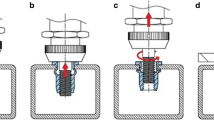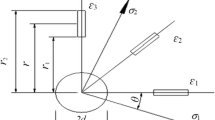Abstract
The present paper derives best practices to accurately simulate the installation process of a Blind Rivet Nut (BRN) using FEA. A BRN is a mechanical fastener used to equip plate material with a threaded part. The installation of a BRN inherently induces a high contact force which can have detrimental consequences when applied to non-metals such as polymer composite materials. The effects of the localized stress in the plate on the mechanical performance of the BRN can be studied with the aid of finite element simulations. To this end, the joining by forming process itself is accurately simulated using a computational efficient axisymmetric 2D model. The 2D model enables to predict the metal flow and internal state of stress after setting with sufficient accuracy. The latter is validated using a full 3D model and a multitude of experimental observations. It is shown that the large strain flow curve of the BRN material needs to be adequately identified. An industrially relevant calibration procedure is presented mitigating the experimental effort. In addition, material test selection in case of highly anisotropic BRN materials is discussed based on a thorough stress state analysis. Finally, the sensitivity of the BRN geometry to a change in the most relevant geometrical parameters is demonstrated. The presented experimental methods and numerical models provide fundamental insights in the forming mechanism including process-induced ductile damage while installing the BRN. The latter will foster the development of new BRN applications in multi-material mechanical design.






















Similar content being viewed by others
References
Dejond (2020) Catalogue blind rivet nuts. https://www.tubtara.com/en/standard-tubtara-blind-rivet-nuts. Accessed 30 October
Borowiecki C, Iluk A, Krysiński P, Rusiński E, Sawicki M (2019) Numerical and experimental investigation of bolted connections with blind rivet nuts. In: Rusiński E, Pietrusiak D (eds) Proceedings of the 14th international scientific conference: computer aided engineering. Springer International Publishing, Cham, pp 88–95
Yoo SY, Kim CH, Kweon JH, Choi JH (2016) The structural analysis and strength evaluation of the rivet nut joint for composite repair. Compos Struct 136:662. https://doi.org/10.1016/j.compstruct.2015.11.012
Klasztorny M, Nycz D (2014) Modelling and numerical study of blind rivet nut / bolt jointsof composite shell segments. In: Pietraszkiewicz W, Gorski J (eds) Shell structures: theory and applications, vol 3. CRC Press
Messler RW (2004) Joining of materials and structures. Butterworth-Heinemann, Burlington. https://doi.org/10.1016/B978-075067757-8/50000-2
Van de Velde A, Coppieters S, Maeyens J, Wevers M, Debruyne D (2020) On the numerical prediction of the torque-to-turn-value of a blind rivet nut. Int J Mater Form 13(1):127. https://doi.org/10.1007/s12289-019-01476-5
Hassanifard S, Adibeig MR, Mohammadpour M, Varvani-farahani A (2019) Fatigue life of axially loaded clamped rivet-nut joints: experiments and analyses. Int J Fatigue 129:105254. https://doi.org/10.1016/j.ijfatigue.2019.105254
Nehls T, Fuchs N, Wanner MC, Schulze M, Wunderlicht C (2017) Vergleich und analyse verscheidener setzverfahren zur herstellung qualittsgerchter blindnietermutterverbindungen. Tech. rep., Europische Forschungsgesellschaft fr Blechverarbeitung e.V Hannover
Sizova I, Sviridov A, Bambach M (2017) Avoiding crack nucleation and propagation during upset bulging of tubes. Int J Mater Form 10(3):443. https://doi.org/10.1007/s12289-016-1292-9
Sviridov A, Rusch M, Almohallami A, Bonk C, Bouguecha A, Bambach M, Behrens BA (2017) Creating load-adapted mechanical joints between tubes and sheets by controlling the material flow under plastically unstable tube upsetting. Procedia Eng 207:968. https://doi.org/10.1016/j.proeng.2017.10.860
Yu H, Li J, He Z (2018) Formability assessment of plastic joining by compression instability for thin-walled tubes. Int J Adv Manuf Technol 97(9):3423. https://doi.org/10.1007/s00170-018-2128-1
De AK, Speer JG, Matlock DK, Murdock DC, Mataya MC, Comstock RJ (2006) Deformation-induced phase transformation and strain hardening in type 304 austenitic stainless steel. Metall Mater Trans A 37(6):1875. https://doi.org/10.1007/s11661-006-0130-y
Lichtenfeld JA, Van Tyne CJ, Mataya MC (2006) Effect of strain rate on stress-strain behavior of alloy 309 and 304L austenitic stainless steel. Metall Mater Trans A 37(1):147. https://doi.org/10.1007/s11661-006-0160-5
Prasad SV, Jonnalagadda KN (2013) Mechanical behavior of SS 304LN at high strain rates in compression. In: Chalivendra V, Song B, Casem D (eds) Dynamic behavior of materials, vol 1. Springer New York, New York, pp 101–108
LSTC (2019) LS-DYNA keyword users’s manual Volume I, r11 edn.
Wanner MC, Henkel KM, Herzogt P, Fuchs N, Glienke R (2009) Einsatz von blindgenieteten funktionselementen in ausgewhlten bauteilwerkstoffen. Tech. rep., Universitt Rostock Fakultt fr Maschinenbau und Schiffstechnik
Coppieters S, Jäckel M, Miyake N, Kraus C, Traphöner H, Kuwabara T, Tekkaya AE (2019) Forming technology forum
Jäckel M, Coppieters S, Vandermeiren N, Kraus C, Drossel WG, Miyake N, Kuwabara T, Unruh K, Traphöner H, Tekkaya AE, Balan T (2020) Process-oriented flow curve determination at mechanical joining. Procedia Manuf 47:368. https://doi.org/10.1016/j.promfg.2020.04.289. 23rd International Conference on Material Forming
Bai Y, Wierzbicki T (2008) A new model of metal plasticity and fracture with pressure and Lode dependence. Int J Plast 24(6):1071. https://doi.org/10.1016/j.ijplas.2007.09.004. http://www.sciencedirect.com/science/article/pii/S0749641907001246
Reddy TY, Reid S (1979) On obtaining material properties from the ring compression test. Nucl Eng Des 52(2):257. https://doi.org/10.1016/0029-5493(79)90055-4
Hawkyard J, Johnson W (1967) An analysis of the changes in geometry of a short hollow cylinder during axial compression. Int J Mech Sci 9(4):163. https://doi.org/10.1016/0020-7403(67)90027-6
Male AT, DePierre V (1970) The validity of mathematical solutions for determining friction from the ring compression test. J Lubric Tech 92(3):389
Sofuoglu H, Rasty J (1999) On the measurement of friction coefficient utilizing the ring compression test. Tribol Int 32(6):327. https://doi.org/10.1016/S0301-679X(99)00055-9
Mahabunphachai S, Ko M (2010) Investigations on forming of aluminum 5052 and 6061 sheet alloys at warm temperatures. Mater Des (1980-2015) 31(5):2422. https://doi.org/10.1016/j.matdes.2009.11.053
Coppieters S, Kuwabara T (2014) Identification of post-necking hardening phenomena in ductile sheet metal. Exp Mech 54:1355. https://doi.org/10.1007/s11340-014-9900-4
Cullen GW, Korkolis YP (2013) Ductility of 304 stainless steel under pulsed uniaxial loading. Int J Solids Struct 50(10):1621. https://doi.org/10.1016/j.ijsolstr.2013.01.020
Felder E, Levrau C, Mantel M, Dinh NGT (2012) Identification of the work of plastic deformation and the friction shear stress in wire drawing. Wear 27:286–287. https://doi.org/10.1016/j.wear.2011.05.029
Funding
No funding was received to assist with the preparation of this manuscript.
Author information
Authors and Affiliations
Corresponding author
Ethics declarations
Conflict of interest
The authors have no conflicts of interest to declare that are relevant to the content of this manuscript.
Additional information
Publisher’s note
Springer Nature remains neutral with regard to jurisdictional claims in published maps and institutional affiliations.
Rights and permissions
About this article
Cite this article
Van de Velde, A., Debruyne, D., Maeyens, J. et al. Towards best practice in numerical simulation of blind rivet nut installation. Int J Mater Form 14, 1139–1155 (2021). https://doi.org/10.1007/s12289-021-01629-5
Received:
Accepted:
Published:
Issue Date:
DOI: https://doi.org/10.1007/s12289-021-01629-5




